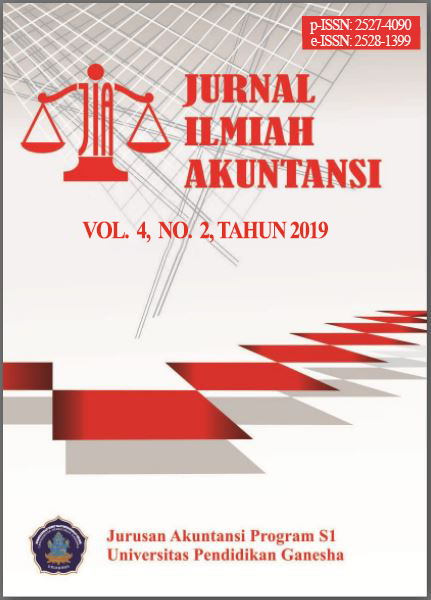Pengaruh Rasio Keuangan, Ukuran Perusahaan, dan Arus Kas Operasi terhadap Harga Saham Syariah
DOI:
https://doi.org/10.23887/jia.v4i2.21404Abstract
Penelitian ini bertujuan untuk menguji pengaruh rasio keuangan, ukuran perusahaan, dan arus kas operasi terhadap harga saham perusahaan yang terdaftar di Indeks Saham Syariah Indonesia (ISSI). Penelitian ini menggunakan data sekunder. Sampel pada penelitian ini sebanyak 164 perusahaan yang terdaftar pada ISSI selama 6 periode dari tahun 2012-2017. Pengujian statistik menggunakan analisis regresi berganda dengan SPSS. Hasil peneilitian ini menunjukkan bahwa variabel return on equity (ROE) sebagai proksi dari rasio profitabilitas, variabel total asset turnover (TATO) sebagai proksi dari rasio aktivitas), dan variabel ukuran perusahaan berpengaruh positif terhadap harga saham. Hasil tersebut mengindikasikan bahwa rasio keuangan dapat meningkatkan harga saham perusahaan. Selanjutnya, total aset yang tinggi pada perusahaan dapat meningkatkan harga saham perusahaan. Namun, variabel net profit margin (NPM) sebagai proksi dari rasio profitabilitas, variabel current ratio (CR) sebagai proksi dari rasio likuiditas, variabel debt to equity ratio DER sebagai proksi dari rasio solvabilitas, dan variabel arus kas operasi tidak berpengaruh terhadap harga saham.
References
Arifin, A. (2004). Membaca Saham. Panduan Dasar Seni Berinvestasi dan Teori Permainan Saham: Kapan Sebaiknya Membeli Kapan Sebaiknya Menjual. Yogyakarta: Andi Offset.
Barbee Jr., W. C., Mukherji, S., & Raines, G. A. (1996). Do Sales-Price and Debt-Equity Explain Stock Returns Better than Book-Market and Firm Size? Financial Analysts Journal, 52(2), 56–60. https://doi.org/10.2307/4479907
Bartram, S. M. (2011). Corporate Cash Flow and Stock Price Exposures to Foreign Exchange Rate Risk. Journal of Corporate Finance, 13(5), 981–984. https://doi.org/10.2139/ssrn.985413
Dimitropoulos, P. E., & Asteriou, D. (2009). The value relevance of financial statements and their impact on stock prices. Managerial Auditing Journal, 24(3), 248–265. https://doi.org/10.1108/02686900910941131
Dutta, A., Bandopadhyay, G., & Sengupta, S. (2012). Prediction of Stock Performance in the Indian Stock Market Using Logistic Regression. International Journal of Business and Information, 7(1), 105–136.
Ghozali, I. (2012). Aplikasi Analisis Multivariate dengan Program IBM SPSS 20 (6th ed.). Semarang: Badan Penerbit Universitas Diponegoro.
Hanafi, M. M., & Halim, A. (2016). Analisis Laporan Keuangan (Kelima). Yogyakarta: UPP STIM YKPN.
Indonesia Stock Exchange. (2019). Indeks Saham Syariah. Retrieved from https://www.idx.co.id/idx-syariah/indeks-saham-syariah/
Kasmir. (2008). Analisis Laporan Keuangan. Jakarta: Rajawali Press.
Kheradyar, S., Ibrahim, I., & Nor, F. M. (2011). Stock Return Predictability with Financial Ratios. International Journal of Trade, Economics and Finance, 2(5), 391–396.
Kieso, D. E., Weygandt, J. J., & Warfield, T. D. (2014). Accounting Intermediate IFRS Edition. Ner York: John Wiley & Sons Inc.
Kohansal, M. R., Dadrasmoghaddam, A., Karmozdi, K. M., & Abolfazl Mohseni. (2013). Relationship between Financial Ratios and Stock Prices for the Food Industry Firms in Stock Exchange of Iran. World Applied Programming, 3(10), 512–521. Retrieved from www.tijournals.com
Lewellen, J. (2004). Predicting Returns with Financial Ratios. Journal of Financial Economics, 74, 209–235. https://doi.org/10.1016/j.jfineco.2002.11.002
Livnat, J., & Zarowin, P. (1990). The Incremental Information Content of Cash-Flow Component. Journal of Accounting and Economics, 13(1), 25–46. https://doi.org/10.1016/0165-4101(90)90066-D
Martani, D., Mulyono, M., & Khairurizka, R. (2009). The Effect of Financial Ratios, Firm Size, and Cash Flow from Operating Activities in The Interim Report to The Stock Return. In Business Review (Vol. 8).
Tandelilin, E. (2007). Analisis Investasi dan Manajemen Portofolio. Yogyakarta: BPFE-Yogyakarta.
Vedd, R., & Yassinski, N. (2015). The Effect of Financial Ratios, Firm Size & Operating Cash Flows on Stock Price: Evidence from the Latin America Industrial Sector. Journal of Business and Accounting, 8(1), 15–27.
Viandita, T. O., Suhadak, & Husain, A. (2013). Pengaruh Debt Ratio (DR), Price To Earning Ratio (PER), Earning Per Share (EPS), dan Size Terhadap Harga Saham (Studi pada Perusahaan Industri yang Terdaftar Di Bursa Efek Indonesia). Jurnal Administrasi Bisnis (JAB), 1(2), 113–121.
Ni, Y., Huang, P., Chiang, P., & Liao, Y. (2019). Cash flow statements and firm value: Evidence from Taiwan. Quarterly Review of Economics and Finance, 71, 280–290. https://doi.org/10.1016/j.qref.2018.09.004
Rosyadi, I. (2002). Keterkaitan Kinerja Keuangan dengan Harga Saham (Studi pada 25 Emiten 4 Rasio Keuangan d BEJ). Jurnal Riset Akuntansi Dan Keuangan, 1(1), 24–48. https://doi.org/10.23917/reaksi.v1i1.3678
Saleh, M. (2015). Relationship between Firm’s Financial Performance and Stock Returns: Evidence from Oil and Gas Sector Pakistan. Journal of Energy Technologies and Policy, 5(10), 27–32. Retrieved from www.iiste.org
Sartono, A. (2012). Manajemen Keuangan Teori dan Apikasi. Yogyakarta: BPFE-Yogyakarta.



1.png)


